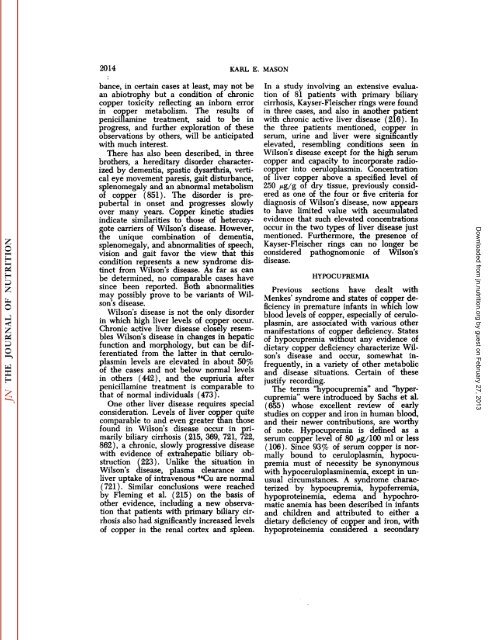conspectus of researchon copper metabolism and requirements
conspectus of researchon copper metabolism and requirements
conspectus of researchon copper metabolism and requirements
Create successful ePaper yourself
Turn your PDF publications into a flip-book with our unique Google optimized e-Paper software.
2014 KARL E. MASON<br />
bance, in certain cases at least, may not be<br />
an abiotrophy but a condition <strong>of</strong> chronic<br />
<strong>copper</strong> toxicity reflecting an inborn error<br />
in <strong>copper</strong> <strong>metabolism</strong>. The results <strong>of</strong><br />
penicillamine treatment, said to be in<br />
progress, <strong>and</strong> further exploration <strong>of</strong> these<br />
observations by others, will be anticipated<br />
with much interest.<br />
There has also been described, in three<br />
brothers, a hereditary disorder character<br />
ized by dementia, spastic dysarthria, verti<br />
cal eye movement paresis, gait disturbance,<br />
splenomegaly <strong>and</strong> an abnormal <strong>metabolism</strong><br />
<strong>of</strong> <strong>copper</strong> (851). The disorder is prepubertal<br />
in onset <strong>and</strong> progresses slowly<br />
over many years. Copper kinetic studies<br />
the unique combination <strong>of</strong> dementia,<br />
splenomegaly, <strong>and</strong> abnormalities <strong>of</strong> speech,<br />
vision <strong>and</strong> gait favor the view that this<br />
condition represents a new syndrome dis<br />
tinct from Wilson's disease. As far as can<br />
be determined, no comparable cases have<br />
since been reported. Both abnormalities<br />
may possibly prove to be variants <strong>of</strong> Wil<br />
son's disease.<br />
Wilson's disease is not the only disorder<br />
in which high liver levels <strong>of</strong> <strong>copper</strong> occur.<br />
Chronic active liver disease closely resem<br />
bles Wilson's disease in changes in hepatic<br />
function <strong>and</strong> morphology, but can be dif<br />
ferentiated from the latter in that ceruloplasmin<br />
levels are elevated in about 50 %<br />
<strong>of</strong> the cases <strong>and</strong> not below normal levels<br />
in others (442), <strong>and</strong> the cupriuria after<br />
penicillamine treatment is comparable to<br />
that <strong>of</strong> normal individuals (473).<br />
One other liver disease requires special<br />
consideration. Levels <strong>of</strong> liver <strong>copper</strong> quite<br />
comparable to <strong>and</strong> even greater than those<br />
found in Wilson's disease occur in pri<br />
marily biliary cirrhosis (215, 369, 721, 722,<br />
862), a chronic, slowly progressive disease<br />
with evidence <strong>of</strong> extrahepatic biliary ob<br />
struction (223). Unlike the situation in<br />
Wilson's disease, plasma clearance <strong>and</strong><br />
liver uptake <strong>of</strong> intravenous 84Cu are normal<br />
(721). Similar conclusions were reached<br />
by Fleming et al. (215) on the basis <strong>of</strong><br />
other evidence, including a new observa<br />
tion that patients with primary biliary cir<br />
rhosis also had significantly increased levels<br />
<strong>of</strong> <strong>copper</strong> in the renal cortex <strong>and</strong> spleen.<br />
In a study involving an extensive evalua<br />
tion <strong>of</strong> 81 patients with primary biliary<br />
cirrhosis, Kayser-Fleischer rings were found<br />
in three cases, <strong>and</strong> also in another patient<br />
with chronic active liver disease (216). In<br />
the three patients mentioned, <strong>copper</strong> in<br />
serum, urine <strong>and</strong> liver were significantly<br />
elevated, resembling conditions seen in<br />
Wilson's disease except for the high serum<br />
<strong>copper</strong> <strong>and</strong> capacity to incorporate radio<strong>copper</strong><br />
into ceruloplasmin. Concentration<br />
<strong>of</strong> liver <strong>copper</strong> above a specified level <strong>of</strong><br />
250 /Ag/g <strong>of</strong> dry tissue, previously consid<br />
ered as one <strong>of</strong> the four or five criteria for<br />
diagnosis <strong>of</strong> Wilson's disease, now appears<br />
to have limited value with accumulated<br />
indicate similarities to those <strong>of</strong> hétérozyevidence<br />
that such elevated concentrations<br />
gote carriers <strong>of</strong> Wilson's disease. However, occur in the two types <strong>of</strong> liver disease just<br />
mentioned. Furthermore, the presence <strong>of</strong><br />
Kayser-Fleischer rings can no longer be<br />
considered pathognomonic <strong>of</strong> Wilson's<br />
disease.<br />
HYPOCUPREMIA<br />
Previous sections have dealt with<br />
Menkes' syndrome <strong>and</strong> states <strong>of</strong> <strong>copper</strong> de<br />
ficiency in premature infants in which low<br />
blood levels <strong>of</strong> <strong>copper</strong>, especially <strong>of</strong> cerulo<br />
plasmin, are associated with various other<br />
manifestations <strong>of</strong> <strong>copper</strong> deficiency. States<br />
<strong>of</strong> hypocupremia without any evidence <strong>of</strong><br />
dietary <strong>copper</strong> deficiency characterize Wil<br />
son's disease <strong>and</strong> occur, somewhat in<br />
frequently, in a variety <strong>of</strong> other metabolic<br />
<strong>and</strong> disease situations. Certain <strong>of</strong> these<br />
justify recording.<br />
The terms "hypocupremia" <strong>and</strong> "hypercupremia"<br />
were introduced by Sachs et al.<br />
(655) whose excellent review <strong>of</strong> early<br />
studies on <strong>copper</strong> <strong>and</strong> iron in human blood,<br />
<strong>and</strong> their newer contributions, are worthy<br />
<strong>of</strong> note. Hypocupremia is defined as a<br />
serum <strong>copper</strong> level <strong>of</strong> 80 ¿ig/100ml or less<br />
(106). Since 93% <strong>of</strong> serum <strong>copper</strong> is nor<br />
mally bound to ceruloplasmin, hypocu<br />
premia must <strong>of</strong> necessity be synonymous<br />
with hypoceruloplasminemia, except in un<br />
usual circumstances. A syndrome charac<br />
terized by hypocupremia, hyp<strong>of</strong>erremia,<br />
hypoproteinemia, edema <strong>and</strong> hypochromatic<br />
anemia has been described in infants<br />
<strong>and</strong> children <strong>and</strong> attributed to either a<br />
dietary deficiency <strong>of</strong> <strong>copper</strong> <strong>and</strong> iron, with<br />
hypoproteinemia considered a secondary<br />
Downloaded from<br />
jn.nutrition.org<br />
by guest on February 27, 2013
















